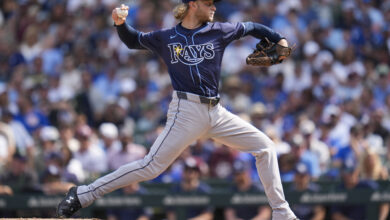Show Me The Money: The Case For Overpaying In Free Agency
In 1999, the highest paid player in MLB was Albert Belle, at $11.9 million per season. Just two years later the top salary belonged to Alex Rodriguez, at $22 million. This underscores the change that has taken place over the last two decades in baseball. Salaries are rising, and some teams aren’t able to compete with the likes of the Yankees and Dodgers on the market.
But I had been thinking about the concept of the “overpay” on free agents, and wanted to dig into salary history to find more information. I gathered data from a few websites with salary information, including a report from the MLBPA that was published in 2009. The information is a few years old, but it’s still applicable.
The average salary of a Major Leaguer with less than a year of service time is around $513K. Add another year of service time and it goes up about $17K. Bump to between two and three years of time, and it goes up another $70K. But for players that are Super 2-eligible, the average salary between years two and three jumps $1.73M. That’s a pretty good reason for teams to avoid Super 2 eligibility, if possible.
The average salary of players before arbitration is somewhere around $600K and the average for players over their first six years, which includes minimum-salary and arbitration-eligible guys, is $1.80M. Once players hit their seventh year, the salaries jump, reaching $7.63M for years 7-15.
None of this should be too surprising. We all know that players that haven’t hit free agency yet cost less money. But I think this knowledge can be used in a unique way.
When people talk about signing Jon Lester (or any other free agent), many discuss the risks of devoting such a large portion of payroll to just one player. Lester is looking at, likely, a six-year deal. But the Cubs have a ton of low-salary young players on the roster, and they’ve positioned themselves to be able to keep their payroll suppressed over the next several seasons.
Let’s look specifically at the Cubs bullpen, is filled with minimum salary-type guys, to illustrate my point. The right-handed portion, with Hector Rondon, Neil Ramirez, Justin Grimm, Pedro Strop, Brian Schlitter, and Blake Parker, stands firm. The left-handed side is a little light at the moment, but it’s possible they roll with a combination of Zac Rosscup, Eric Jokisch, Tsuyoshi Wada, and Joe Ortiz.
Assuming seven of those guys make the final roster, you’re spending roughly $5-$10M on the ‘pen. Compared to teams that are shelling out $9M per season on a set-up guy, that’s a bargain.
The Cubs currently have (including estimates in arbitration) about $70M tied to 36 players on the 40-man roster. Going with the idea that they should have between $110m-120m to spend on the 2015 payroll, that leaves quite a bit to spend on just a few open spots.
Jon Lester is the most obvious example, so what’s the issue with overpaying for him? In theory, the Cubs could give him $30M in AAV (6-years, $180m) and still only bring their payroll to $100M. Assuming no trades that shed salary, such as dumping Edwin Jackson or Travis Wood, you could still sign a guy like Justin Masterson and an outfielder like Jonny Gomes to platoon with Chris Coghlan in left, and have a little flexibility left in your payroll.
Now, I’m not advocating throwing that deal at Lester. There obviously has to be some sort of ceiling on what you’re prepared to offer, otherwise you end up bidding against yourself. But the fact is, if you are shopping for top talent on the open market, you almost always have to pay an inflated price. Consider not only that the average of the top 20 salaries in baseball currently is slightly more than $24M for the upcoming season, but also the ever-changing economy of the sport as well.
The inflation of the average salary in baseball from 2008-2014 was about 30%. If the Cubs gave Lester $30M in AAV and the inflation stays the same, the last year of the contract would be worth $22M in “2015 dollars.” The list of players making around that much in 2015 includes Jacoby Ellsbury, Matt Kemp, Carl Crawford, Jayson Werth, Adrian Gonzalez, Jose Reyes, Masahiro Tanaka, Alex Rodriguez, Miguel Cabrera, Joe Mauer, C.C. Sabathia, and Mark Teixeira.
That may help to add perspective to the thought that $30M in AAV for Lester would be a massive overpay.
Now, is paying him that much a risk? Absolutely it is, no doubt about that. But Theo Epstein has made it clear that, at some point over the next fifteen months, they intend to acquire an ace (or two) to push them from young-club-on-the-rise to serious contender. Lester offers the unique opportunity to land an ace starting pitcher without giving up draft picks or prospects. If he’s not the one you plan to overpay, that’s fine. David Price, Jordan Zimmermann, Rick Porcello, Max Scherzer, and others will be out there too.
But if you don’t have an ace in the farm system and you don’t want to give up a top prospect or two, overpaying one of those guys is necessary. Fortunately for the Cubs, they’ve built their team to be able to do that. Now they just have to put their money where their mouth is.

